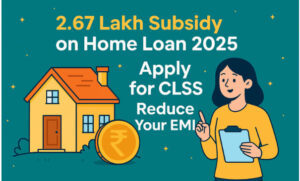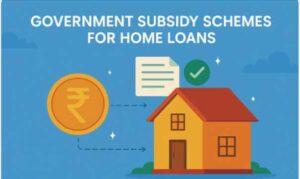The Pradhan Mantri Awaas Yojana – Gramin (PMAY-G) is the Government of India’s flagship rural housing scheme, launched on 1st April 2016. Operated by the Ministry of Rural Development (MoRD) and supported by the Ministry of Housing and Urban Affairs (MoHUA), PMAY-G aims to achieve “Housing for All” by providing pucca houses with basic amenities to eligible rural households living in kutcha or dilapidated homes.
With over 2 crore houses already built by September 2022, the mission continues its endeavor to uplift rural families by ensuring dignified living conditions.
Key Highlights PM Housing Scheme – Rural
• Scheme Name: Pradhan Mantri Awaas Yojana – Gramin (PMAY-G)
• Launch Date: 1st April 2016
• Implemented By: Ministry of Rural Development (MoRD)
• Target: 2.72 crore rural households
• Minimum House Size: 25 sq. m (including a kitchen)
• Financial Assistance: ₹1.20 lakh (plain areas), ₹1.30 lakh (hilly/IAP areas)
• Subsidized Loan: Up to ₹70,000 at 3% interest concession
• Convergence with: SBM-G, MGNREGA, Ujjwala Yojana, and other schemes
• Mode of Fund Transfer: Direct Benefit Transfer (DBT) to Aadhaar-linked bank/post office accounts
Objectives of PMAY-G
• Provide pucca houses to all houseless and kutcha house dwellers in rural India
• Ensure convergence with key government schemes for sanitation, fuel, electricity, and water
• Enable quality construction using local materials, trained masons, and sustainable designs
• Promote livelihood generation through Rural Mason Training (under MGNREGA)
Benefits of the Housing Scheme
• Financial Grant:
-
₹1,20,000 for plains
-
₹1,30,000 for hilly/remote/IAP districts
• Subsidized Loan:
-
Optional loan of up to ₹70,000 at 3% lower interest (for eligible beneficiaries)
-
Maximum subsidy on ₹2 lakh loan principal
• House Design: Minimum area of 25 sq. meters with hygienic cooking space
• Convergence Benefits:
-
₹12,000 under Swachh Bharat Mission – Gramin for toilet construction
-
95 days of unskilled labor at ₹90.95/day under MGNREGA
-
Free LPG connection under Pradhan Mantri Ujjwala Yojana
-
Access to schemes for piped water, electricity, clean cooking, and waste management
• Direct Benefit Transfer (DBT): Money is directly credited to the beneficiary’s Aadhaar-linked account
Eligibility Criteria
Core Eligibility (Based on SECC 2011):
• Houseless households or those living in zero/one/two-room kutcha houses
• Verified by Gram Sabhas based on Housing Deprivation Parameters
• Should not own a pucca house or have more than two rooms with pucca walls/roof
Automatic Inclusion (High Priority):
• Households without shelter
• Destitute or living on alms
• Manual scavengers
• Primitive Tribal Groups
• Released bonded laborers
Additional Prioritization:
• SC/ST, minorities, and others—based on deprivation score
• Female-headed households, households with disabled members, landless laborers, etc.
• Preference given to:
-
Widows, dependents of martyrs
-
Leprosy/Cancer/HIV patients
-
Single-girl child households
-
STs/Forest Dwellers (under FRA 2006)
-
Transgender persons
Earmarking of Targets
• SC/ST: Minimum 60% of the state/UT targets (interchangeable if no eligible beneficiaries found)
• Minorities: Up to 15% of national fund allocation based on Census 2011 population data
• PwDs: At least 3% of the state-level beneficiaries, wherever applicable
Who is not covered under the PM Rural Housing Scheme
Step 1: Pucca House Check
• Households with pucca roof/walls or more than two rooms are excluded
Step 2: Automatic Exclusion (Any 1 of 13 conditions):
• Own vehicle (2/3/4-wheeler or fishing boat)
• Mechanized agricultural tools
• Kisan Credit Card (limit ≥ ₹50,000)
• Government job holder in the family
• Registered business
• Income above ₹10,000/month
• Paying income/professional tax
• Own fridge, landline phone
• Owns≥ 2.5 acres of irrigated land with equipment
• ≥ 5 acres irrigated land for 2+ crops
• ≥ 7.5 acres of land with irrigation
How to Apply – Online Process
Step 1: Visit the PMAY-G Official Portal
Step 2: Log in using credentials or register a new beneficiary
Step 3: Fill in the four sections:
-
Personal Details (Name, Aadhaar, Gender, Mobile)
-
Bank Details (Account Number, IFSC, Aadhaar-linked)
-
Convergence Details (MGNREGA Job Card, SBM Number, LPG, etc.)
-
Office Section (filled by department)
Step 4: Upload Aadhaar consent form and click “Submit”
User Manual: PMAY-G Beneficiary Registration Guide (PDF)
Necessary Documents for Application
• Aadhaar Card (with self-attested copy or thumbprint-based consent)
• MGNREGA Job Card
• SBM Number (for toilet convergence)
• Bank Account Details
• Affidavit declaring the applicant or family does not own a pucca house
Frequently Asked Questions (FAQs)
Q: What financial aid is provided under PMAY-G?
A: ₹1.20 lakh in plains and ₹1.30 lakh in hilly/IAP areas per unit, plus ₹12,000 for toilet construction.
Q: Is loan assistance available?
A: Yes, optional institutional loans up to ₹70,000 are offered at a 3% interest subsidy.
Q: Who identifies PMAY-G beneficiaries?
A: Using SECC 2011 data, verified by local Gram Sabhas based on deprivation parameters.
Q: What are the convergence benefits?
A: Employment under MGNREGA, sanitation under SBM-G, LPG under Ujjwala, etc.
Q: Who implements PMAY-G?
A: The Ministry of Rural Development (MoRD), in coordination with state governments.
References & Important Links
• PMAY-G Official Website
• Beneficiary Registration Manual – PMAY-G (PDF)
• Guidelines – PMAY-G English
• SECC Data Portal
• PMAY-G Dashboard



